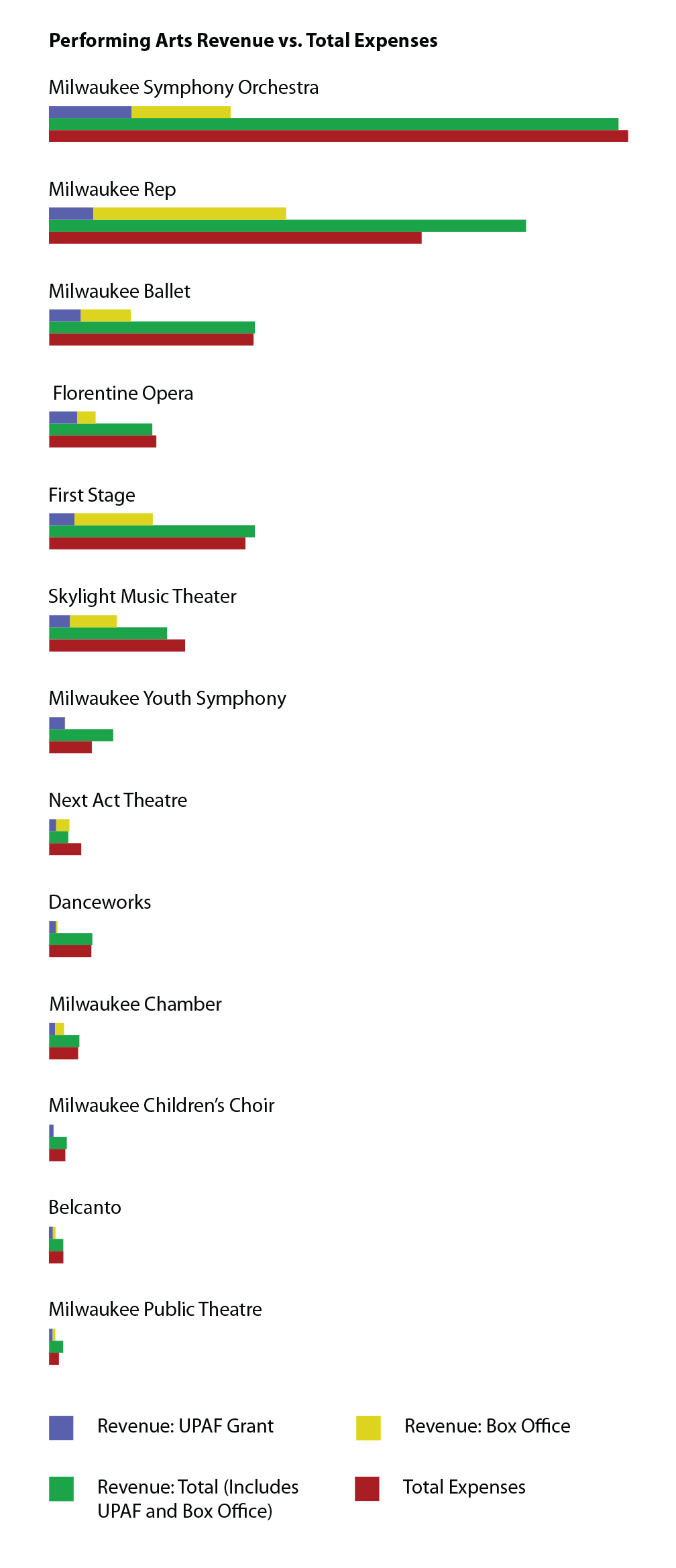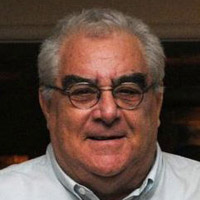The culture of culture
Keeping the arts humming as Milwaukee’s "economic engine".
You can measure almost anything with numbers.
How much do you weigh? How many houses in your block? How many kids do you have? What’s the temperature? How often do you go to the movies?
Numbers are the easy way to measure things. We all understand the numbers. Give us a number, and we get it.
In some respects, the numbers work just as well for the arts.
How many theaters does a city have? Music groups? Dance groups? How much money is raised to support these groups? How much money does the government provide? How many people go to the ballet? The opera?
How much, how many, how long?
That’s the stuff you can put on paper. But there is no piece of paper that will hold the real answer to the big question.
What is the status of the performing arts in Milwaukee?

Walt Kelly is not an artist. He is an attorney, one of a handful of legal lions who waged incredible battles as this city moved toward civil rights for all of its citizens. His place in Milwaukee history is firm, alongside big names like Coffey and Shellow and Sutton. He has a thriving practice today and is a serious supporter of the performing arts in the city.
"The performing arts give a city its heartfulness," Kelly said. "Laughter and tears, sorrows and cheers, surprise and awe are their measure. If a city is lucky — and so far we are — the performing arts inform and delight our humanity and keep us together through good times and bad."
The performing arts give a city its heartfulness.
Like Kelly, those of us who live here come easily to the conclusion that we are lucky, indeed, to have a flourishing roster of the performing arts to entertain us. We take a quiet pride in our performers, with "quiet" being the operative word.
But there are questions, some of which can be answered with numbers. Others require deeper reflection and are more a matter of taste, artistic standards and feeling.
When you begin the search for answers, there are three basic questions.
Are the performing arts important to your city?
Do we have enough performing arts venues and companies?
How good are we?
Do the performing arts matter?

The United Performing Arts Fund calls the arts an "economic engine" for the city. About 6,000 people are employed in the arts in Milwaukee, and that comes out to about $100 million in annual wages.
With an annual fundraising drive that benefits 15 member groups as well as a number of small groups, called affiliates, UPAF is perhaps the best source for trying to quantify the value and importance of performing arts in the city.

"There has been a lot of research done on the value of the performing arts to a city," said Deanna Tillisch, UPAF’s president and CEO. "We talk to a number of CEOs and officials from a wide variety of companies. They all say that it’s critically important for us to showcase all the attractions here in Milwaukee when it comes to attracting and keeping talented and creative employees. They all emphasize that the performing arts are central to our story.
"The relationship between the performing arts and the world of business is mutually beneficial. Businesses are recognizing the importance of innovative thinking when it comes to being competitive. They realize the need to ensure that their employees have access to ways they can use their imagination to be creative. It’s not just arts education in schools but it’s something you have to cultivate and sustain through your entire life."

As president and CEO of VISIT Milwaukee, Paul Upchurch is intimately engaged in attracting conventions and tourists and recognizes the importance of both the image and realities of the performing arts community.
"Research proves that a thriving arts and culture scene is critical to the overall economic success of a city. It’s what makes a city come alive," Upchurch said.
"Tourists plan their vacations around food, arts, culture and music offerings. Meeting planners look for cities where there are museums, theaters and unique venues because there are more options for entertainment and event spaces. Milwaukee’s dynamic arts and culture offerings are one of the key selling points that we use to draw people to the region."
But the performing arts are much more than an economic engine or a lure for out-of-staters. As Walt Kelly said, "the performing arts give a city its heartfulness."
Working as an actor, a musician, a dancer or a singer is not a ticket to riches. There’s a famous, unattributed quote about the theater that says "nobody does theater because they want to, but they do it because they have to." That is easily applicable to anyone who works in the performing arts.
Perhaps the best way to understand the importance of the performing arts is to listen to those who do it, not because they want to, but because they are driven to be on a stage, both for their soul and the soul of the audience.

"The arts bring life to life. They make the experience of being more human more vivid," said Jill Anna Ponasik, producing artistic director for Milwaukee Opera Theatre. "I can bounce my own human experience off it. It’s your humanity. It awakens our recognition of what it means to be human."

"I hope that the work we do provides audiences and artists alike with insight into our fellow human beings, and a revealing glimpse of the conditions, events and challenges that surround each one of us," added David Cecsarini, producing artistic director at Next Act Theatre.
"The more you find out about someone else, usually, the more difficult it is to hate or dismiss them."
There are few who would argue that the performing arts are unimportant on so many different levels.
In a study called, "Pulling Back the Curtain," Milwaukee’s Public Policy Forum noted, "In late October, a feature in The New York Times travel section praised the virtues of Milwaukee, saying the city ‘possesses a renewed vitality while still holding on to an Old World character.’ A review of other recent travel articles from dozens of national publications reveals that this characterization is not uncommon.
The more you find out about someone else, usually, the more difficult it is to hate or dismiss them.
"Indeed, most of those publications view Milwaukee as a city that is comfortable with its industrial and beer-making past, but that also has — in the words of Fodor’s Travel — "morphed itself into a multi-faceted destination with world-class art and award-winning restaurants."
But they don’t come without a cost.
Last year, according to the individual tax returns, the 15 members of UPAF sold over $14 million worth of tickets. According to their Form 990 nonprofit tax returns, the same 15 groups had expenses of $49 million.
The difference is made up in a variety of ways including gifts, grants, ticket handling charges, schools and direct donations. Government funding for the performing arts is relatively negligible and most of the funding comes from the United Performing Arts Fund.
UPAF & money

The United Performing Arts Fund was established in 1967 to raise funds to support the performing arts, and it is one of the most successful organizations of its type in the nation.
It is the big dog when it comes to funding the performing arts in Milwaukee. In the last 10 years alone, UPAF has raised more than $102 million.
The organization is overseen by a board of directors made up of powerful and influential business and organizational leaders in Milwaukee.
UPAF has 15 member groups which receive the bulk of the money raised annually. Six of the groups are considered cornerstone groups — the Milwaukee Symphony, the Milwaukee Repertory Theatre, the Milwaukee Ballet, Skylight Music Theater, First Stage and the Florentine Opera.
In the last 10 years, the 15 member groups have remained the same except for 2009 when the Milwaukee Children’s Choir replaced Bialystock & Bloom, a cutting-edge theater company that went out of business.
In 2014, UPAF raised just over $10 million and allocated more than $8.5 million to its 15 member groups and $117,500 to 23 affiliates. Those dollar figures are right in line with most other cities of a similar size. However, most cities provide assistance to many more groups than does UPAF. Cincinnati, for example, provides support for more than 100 groups.
UPAF uses a formula developed by Northwestern Mutual to determine the size of individual grants, and Tillisch said 92.3 percent of the annual grants from UPAF go to the six cornerstone groups. The rest is spent on the affiliate groups and on the business operations of UPAF.
The money from UPAF allows groups in Milwaukee to function at their present high level. Without UPAF support programming and quality would suffer drastic reductions.
"You want to have something for everyone in the city," Tillisch said. "Opera may not have as many seats filled as The Rep, but the people who go to the opera are incredibly passionate. There is a distinctiveness about each of those arts forms that solidifies the culture that we have in this community. Sustainability of those cornerstone groups is critical to the economic engine of this community. When we look at adding additional member groups we have to take that into consideration.
"We want to make sure they (the member groups) are allowed to take risks," continued Tillisch. "And maybe a show doesn’t perform at a level they thought it would, but it’s still an important performance to stimulate dialogue that we should have as an art form. That’s why we have the ongoing funding to give them the flexibility to do this."
UPAF is not without its critics, however, some of whom come from the artistic community. Nobody is willing to talk on the record, fearing their comments may jeopardize support from UPAF, but there are concerns about who gets UPAF how much money and the fact that there have been virtually no new groups added to the member list in the past decade.

The performing arts landscape is ever-changing, and there is a feeling that UPAF doesn’t pay enough attention to the growth and importance of some groups and seems stuck on the status quo. There are also complaints about the allocation formula designed by Northwestern Mutual. Many artists complain that the standards and practices that come from business experience have little bearing on performing arts organization.
"Right now, the board is very comfortable to keep the number of groups at 15," Tillisch said. "We are in the process of examining the number of organizations that UPAF can fund without cannibalizing what is needed for cornerstone groups.
"There are processes for a group to move into the member group. There are different criteria the groups have to meet. Primarily it’s a budgetary thing."
What that means, of course, is that the bigger your budget, the more seriously UPAF considers where you rank on the list of performing arts groups that are funded. In the view of some that seems to almost cannibalize the fund raising of individual groups. They have to prove to UPAF that they have money to spend in order to get money to spend.
Some people say that the box office test ought to be taken into consideration more than it is. Several people, for example, pointed out that Florentine Opera is a cornerstone group when its 2014 box office revenue was just $507,101, based on tax records. The Florentine’s UPAF grant exceeds the one to First Stage, which had $2.1 million in box office revenue and Skylight which earned $1.3 million at the gate. Simply put, more people like and attend Skylight and First Stage productions than those that attend Florentine shows.
Tillisch said that the box office is not the only thing considered when determining the grants.
"When you look at the cornerstone groups, they are growing in popularity but some are not growing as fast as others," she said. "Popularity can’t be the only thing that counts.You can’t rely exclusively on market demand to determine the value of an organization."
Government contributes a relative pittance to the arts groups in Wisconsin, which ranks 49th in public spending on the arts.
The issue of money, of course, is of critical importance to performing arts groups. Government at the state, county and local level contributes a relative pittance to the arts groups, especially in Wisconsin, which ranks 49th in public spending on the arts, at just 14 cents per capita. Only Kansas spends less, at half that.
One of the issues facing these groups is that many of the donors come from the corporate world of business and think that business efficiency models should apply to the world of the performing arts.
"That doesn’t always work," said the artistic director of one company. "We aren’t making widgets. If you are doing Beethoven, you do it with the same number of musicians that were there when Beethoven was alive. Anything less is, well, less."

Mark Niehaus, the president and executive director of the Symphony, said that corporate business model doesn’t work perfectly for the performing arts.
"There is not a robust understanding of what these organizations look like when they are successful," he said. "None of the cornerstone groups are properly set up. We don’t have endowments. We don’t control our own venue. So our earned revenue is subject to the whims of the scheduling. It’s outside our control."
There is also an intense debate about whether UPAF should spend more money nurturing the smaller developing groups or whether they should continue to provide the overwhelming bulk of money to the cornerstone groups.
One artistic director who has run both small and large companies said his opinion has changed over the years.
"To be honest about it, when you look at what elevates the community from a national and international perspective," he said, "it’s the work being done by the cornerstone groups. Look at the reputation that Michael Pink and the ballet have, not just in this country but around the world. The small groups do a great job creating exciting little art. But when you are talking about a community of our size what’s really going to build our city are the cornerstone organizations.
"But every time you siphon off that $5,000 that goes to a smaller organization, it cuts into what we are trying to do. The smaller theaters funnel up artists and performers but often their creativity is born out of struggle, and some of that is financial."
Another artistic director of a member company said that UPAF fills a crucial need for the cornerstone groups.
"In the creative jungle it takes all kinds of exotic creatures and individuals to build a balanced ecosystem," he said. "There is no question that the money that is raised is to do what it was designed to do — to take some of the pressure off of the major groups. UPAF must allow the law of the jungle to allow people to struggle and build relationships."
Part of that jungle is the cost of doing what you hope is great art. And many of those costs hit hard when, as Niehaus pointed out, a performing arts group doesn’t control its own venue.
Rent is a major expense and has an impact on the ability to stage enough performances to allow every opportunity for audience members to see a group’s performances.
The ballet, for example, does four performances of its productions at the Marcus Center for the Performing Arts. The Marcus provided figures that show the average cost per week of use by the ballet is $71,000. For the Florentine the figure is $77,000.
The ballet or Florentine can’t scrimp on rehearsal time or the size of a cast. Their preparation is the same whether the run is going to be one performance of 10 weeks of performances. There are no programmatic cutbacks that won't have an immeasurable impact on the performance.
"The emotional and artistic cost of that kind of rent is immeasurable," Michael Pink, artistic director of the Milwaukee Ballet said. "Any performing artist grows from the experience of being in front of an audience. It’s through that you evolve and grow. The idea that our dancers, principals, only dance two shows each is idiotic. It’s hard for our audiences as well because they only have this one weekend to show. And it is all a function of rent."
Theater

Milwaukee is blessed with more theater offerings than most cities our size. The roughly 30 professional and semi-professional theaters here are more than in Pittsburgh, Cincinnati, Cleveland or Oklahoma City.
Groups range from the Milwaukee Repertory Theatre at the top of the pyramid to smaller groups like All In Productions and Off the Wall Theatre, run by Dale Gutzman, this year’s City of Milwaukee Artist of the Year.
The Rep was founded in 1954 and has been in operation ever since, making it one of the longest running regional theaters in the country. The company moved into their present home in 1987 and does about 600 performances a season, with more than 200,000 seats in three theaters.
Mark Clements was named artistic director in 2010 and has led a resurgence of the theater, staging a mixture of high-powered musicals, searing dramas and sharp and intelligent comedies.
The Rep is not among the top rank of regional theaters in the country — theaters like The Guthrie in Minneapolis, the Cleveland Playhouse, the Actors Theater of Louisville, La Jolla Playhouse and both the Goodman and Steppenwolf theaters in Chicago — although under Clements, it is headed in that direction. Also, much of that kind of status is based on reputations which are notoriously difficult to change.
In some respects The Rep, like a lot endeavors in Milwaukee, suffers because the city is located between Chicago and Minneapolis, both of which have more acclaimed reputations than Milwaukee.
There are a several theaters just a step away from The Rep — Milwaukee Chamber Theatre, Next Act Theatre and Renaissance Theaterworks, all of which are member groups of UPAF and all of which produce high-level and interesting theater each season.

One of the most consistently interesting companies in Milwaukee is Gutzman’s Off the Wall Theatre. Gutzman, who has been involved in theater in Milwaukee for over 50 years, produces plays with a tiny budget and new and emerging actors, occasionally sprinkled with an Equity performer. And his theater is an example of the innovation and fresh blood you see in this city.
"I’ve always said that Milwaukee audiences will go see ‘Fiddler on the Roof’ every two weeks," Gutzman said. "I'm committed to trying to stretch things. I’ve always tried to get a couple of the best actors I can find and then fill in with younger and less experienced actors."
He continually swings for the fences, and while there is an occasional strikeout, more often than not he mounts productions that are unique and fascinating.
Last season, for example, he did "Romeo and Juliet" and cast both leads with actors in their 60’s and set the play in an home for old actors in Italy. What’s more he played the whole thing straight, not as a camp version it might have been.
Renaissance is a woman-focused company that has provided significant opportunity to women directors and playwrights that might not be available in other companies.

Julie Swenson, the company’s producing artistic director, said that it has not always been easy to maintain a focus on women, but that over time the attitude has changed.
"Maybe it’s a sign of the times that in 2015 we can say we are a women’s company without the women’s libber thing," she said. "We are a theater company without label or fear. It took a long time for us to get there."
We are a theater company without label or fear. It took a long time for us to get there.

One of the issues that still faces the theater community is a lack of ethnic diversity. Marti Gobel is a black actor who may work as much as any actor, black or white, each season.
"A lot of it is a lot of the companies in town are really old boys clubs," Gobel said. "Or maybe it’s old familiarity clubs. Producers tend to hire the same people who they have worked with before.
"Minorities and women directors are not only in short supply, their voice is not put on top of some wonderful tales. When you have a woman direct a male centric play, you get a whole wealth of information you may not get with a male director.
Because they aren’t given a chance, a lot of young women and minority actors simply leave town. The systemic problem is that we don’t get a lot of new blood.
"When do you see a black person directing a white play? Never."
Clements and the Rep have staged a number of diverse productions and the just-announced collaborations with the Bronzeville Arts Ensemble will provide more opportunities for black theater workers in the city.
Dance

According to UPAF, there are approximately 20-25 dance companies in Milwaukee, headlined by the Milwaukee Ballet, guided by Pink, who became artistic director in 2002.

The Ballet has had a turbulent history, sometimes forgoing a live orchestra, establishing partnerships with other ballet companies that didn’t work out and a constant struggle to broaden it's reach in Milwaukee.
Pink has changed the culture and the reputation of the ballet.
He is respected worldwide for his choreography and design of performances. His focus has always been on telling a story, and his company has always been a avery capable extension of his concepts.
The ballet achieved a milestone last year when PBS broadcast Pink’s "Peter Pan" nationally. The telecast, produced by Milwaukee Public Television, garnered accolades throughout the dance world.
San Francisco dance critic Carla Escoda recently wrote about Milwaukee on the Huffington Post.
"Michael Pink and his team perform a minor miracle every year," she wrote, "running a 25-dancer company along with a dedicated ballet orchestra of 48 musicians, boosting attendance on a budget of just under $6 million, producing two full-length narrative ballets a season and mixed bills that feature classic and new work by an eclectic ensemble of choreographers. In addition to the money-spinning ‘Nutcracker,’ plus a distinguished choreography competition that draws up-and-coming dance-makers from around the world."
Pink also extends the reach of the ballet, working with other companies in town like the Rep and Skylight to bring his unique and high-level brand of choreography to other productions.
Milwaukee also has a number of smaller dance companies, some of which, like the Milwaukee Ballet, hold classes for hundreds of young dancers. Their reputation is generally highly regarded as performance vehicles, but the lessons form a significant backbone for their task.
Theatre Gigante is an inventive troupe that blends dance with theater and the results are sometimes staggeringly good. "The Moor of Venice" is one of the greatest tragedies written by Shakespeare, and the reworking by Isabelle Kralj and Mark Anderson was the kind of production that makes dance such a powerful experience.
Music

There are slightly more than 30 musical groups in Milwaukee, ranging from the huge Milwaukee Symphony to the small Festival City Symphony, to the world famous Fine Arts Quartet.
While financial difficulties have seemed to dog the MSO for years, they have never seemed to have any serious impact on the skill and reputation of the symphony.
The symphony was formed in 1959 by members of the community who thought the city should have its own orchestra, after years of Chicago Symphony performances in Milwaukee.
In 1972, conductor Kenneth Schermerhorn took the symphony to Carnegie Hall for the first time. The musicians were greeted with standing ovations and almost universal praise from the tough New York critics. And that admiration has continued.
In 2012, the symphony was invited to perform at the annual Spring for Music at Carnegie Hall, a series that invites top regional orchestras to perform.
"The core purpose of Spring for Music is to encourage and reward imaginative and eloquent programming," wrote Matthew Murphy, music critic for The New York Times. "And the Milwaukee lineup on Friday certainly came as a surprise to one who had known the orchestra chiefly from its formative years. Mr. de Waart (music director Edo de Waart), no surprise, showed full command here and in the more standard works. And the responsive orchestra shone everywhere."
The orchestra also has a broad impact on music in Milwaukee, far beyond its own concerts.
"Milwaukee has quite a lot of classical music offerings," Niehaus, the executive director said. "The symphony is the largest performing arts group in Wisconsin with a budget of $17 million a year and the most performances. But our musicians also populate music faculties and play for other companies. Our reach is one of the arguments for having a professional orchestra."
The symphony is not without its challenges, though.
The endowment for the symphony pales by comparison to many others. An endowment earns interest that is used to fund programs for arts groups like the symphony.
"We are now down to 68 full time musicians," Niehaus added. "We have trimmed and trimmed. Further cuts will not help; it will start to affect the quality. Our collective bargaining agreement calls for 88 musicians. We are at the lowest level since our infancy."
Despite the money woes, Niehaus is optimistic about the future and exceedingly proud of the work the symphony does.
"I wish we had playoffs the way the Packers and Brewers and Bucks do," he said. "You could see your symphony against other cities. I would argue that day-in day-out the Milwaukee Symphony performs as highly as orchestras that have budgets twice our size."
Day-in day-out the Milwaukee Symphony performs as highly as orchestras that have budgets twice our size.
A plan for the future

If there was one recurring theme in all of the discussions with Milwaukee artists, it was the need for some cohesive plan for the performing arts.
A plan is one of the "opportunities" suggested by the Public Policy Forum in its "Pulling Back the Curtain" report..

Viswa Subbaraman, who ran a small opera company in Houston before coming to the Skylight, has seen that kind of planning be a huge benefit to the performing arts.
"We need a robust cultural plan," he said. "Like New York, Houston, Atlanta and Chicago and Madison. The whole idea of a plan is that it’s about the entire city. Neighborhoods that have a culture to celebrate should be part of it.
"One of the reasons Houston did it was because nationally and internationally they were still perceived as a Hicksville and an oil town. And yet they wanted to raise the level the of jobs that came in and the companies that came in. While they have a basketball team and football team, the arts help drive international businesses to start companies there. It can’t just be about our wonderful park system. If you want companies to come in and you want high-paying, highly intellectual, highly educated jobs to offer then the arts have to be a component of that.
"This is a perfect time to do this because of the whole arena discussion and the new entertainment district. It seems to me that this is a crucial moment to get together. But it can’t just be another group of 40 odd people discussing things. If you look at the mixture of people who are representative of our city, that’s who needs to be in the discussion."
Pink believes that public leadership is a critical element of any such plan.
"I think the government has to be involved," he said. "We have to direct tax dollars effectively. The question is finding the right team, the caliber of people they bring together to start to put the plan together. The plan is only worth as much as the people who will put it together.
"All of the local communities around the city and particularly the areas that are suffering the most with crime and segregation. Those are the places that have to have as loud a voice in a cultural plan and have to show leadership within their areas. The government involvement is important in terms of of being able to provide the credibility and the commitment."
Milwaukee County Executive Chris Abele told OnMilwaukee that he would be willing to help facilitate the creation of a body to help develop a plan for the performing arts.
"It has to be realistic," Abele said. "Obviously I’m very interested in the arts and I know how important they are. But there is no sense doing this unless it’s a realistic plan that works for the whole county."
David Chambers — the head of the directing department at Yale Drama School and a world respected director who spent time in Milwaukee directing a memorable production of "The Merchant of Venice" for the defunct Milwaukee Shakespeare — spoke eloquently about what the performing arts mean to a community like Milwaukee.
"The humanity and livability of a city can be measured by its commitment to the arts, to education, and to its care for the homeless and elderly," he said. "Communities that stand indifferent to the necessity of the arts do so at their own peril. Cultural depth bottoms out in the shallow end of the collective good; our lives become smaller and morally truncated.
"The arts are not a luxury, they are a moral and ethical necessity: the arts are where we turn to see ourselves, to explore who we are and how we should act for good amidst one another. Take that away and all a city has is indecent wealth on the one hand and broken streets and dreams on the other."




